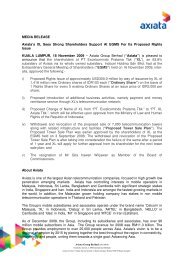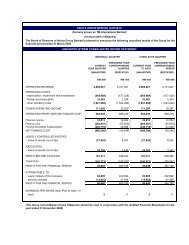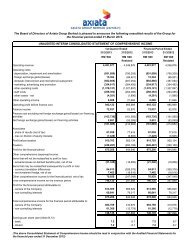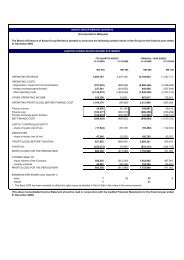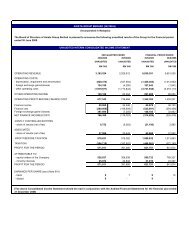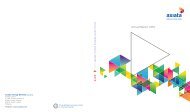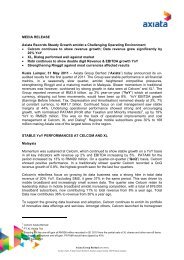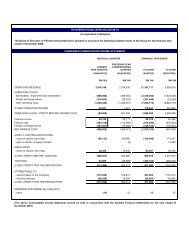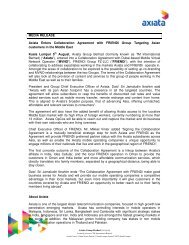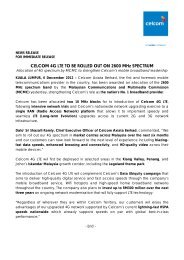Annual Report 2012, PDF - Axiata Group Berhad - Investor Relations
Annual Report 2012, PDF - Axiata Group Berhad - Investor Relations
Annual Report 2012, PDF - Axiata Group Berhad - Investor Relations
Create successful ePaper yourself
Turn your PDF publications into a flip-book with our unique Google optimized e-Paper software.
KEY RISKAREAS IDENTIFIEDAPPENDIX 11. Long Term Business Strategy: There has been asignificant shift in subscribers spending behaviourwhere providing traditional mobile voicecommunications is no longer attractive or sufficient.The growing popularity of smartphones and androiddevices increases the need for data services. Thusthe <strong>Group</strong> constantly explores and makes appropriateinvestments to upgrade its technology and platformsto enhance its preparedness in keeping its productsand services relevant. The <strong>Group</strong> is also cognisant ofthe latest industry and subscriber trends, continuouslyreviewing and proactively making changes to itsbusiness model, fast-tracking ROI on its investmentsand ensuring the long term competitiveness andfinancial performance of the <strong>Group</strong>.2. Significant Increase in Domestic Competition:Increased competition from existing and new mobileoperators would result in price wars and competitiveproduct offerings in voice and mobile data services.Management is continuously monitoring thedevelopment of the domestic business environmentand taking measures in ensuring that the <strong>Group</strong>remains competitive.3. Adverse Regulatory, Legal and PoliticalDevelopment: The <strong>Group</strong> operates in an industrythat is subject to a broad range of rules andregulations, put in place by various governing bodiesand political frameworks. While some jurisdictionsare relatively stable and hence predictable in nature,some territories have a somewhat robust politicalclimate. As such, the <strong>Group</strong> faces unexpectedchanges in laws, rules and regulations, that couldmaterially affect the growth, prospects, financialcondition or operations of the <strong>Group</strong>. At the sametime, the <strong>Group</strong>’s operating licences are subjectedto renewal, interpretation, modification or terminationby relevant authorities. New conditions andobligations may be imposed for new licences andupon renewal of expiring licences and such conditionsmay be more onerous than previously. Any failurescould impede the ability of the <strong>Group</strong> to continue tooperate the affected business and the realisablevalue of its relevant network infrastructure andrelated assets may be adversely affected. As such,the <strong>Group</strong> emphasises strict compliance, constantlykeeps up with all relevant developments and is inregular contact with the governing authorities.4. Dependence on Major OpCos: The <strong>Group</strong>’s financialresults depend on the contribution of two majorOpCos, namely Celcom and XL, which account formore than 80% of revenue and 90% of PATAMI.Any major adverse developments in these twoOpCos could materially affect the <strong>Group</strong>’s financialperformance.5. Substitution Risk: There is a risk that the emergenceof non-traditional ‘Over-The-Top’ service providersthat provide free VoIP calling and messaging, couldimpact our core revenue base. The <strong>Group</strong> isproactively looking into mitigation strategies toensure that the impact of substitution is minimised,such as the bundling of voice and data.6. Technology Obsolescence: The uncertainty relatedto the speed of development and deployment ofnew technologies and the potential readiness ofrelated ecosystems such as that of fourth generationnetworks creates potential risks (i.e. shortertechnology lifecycle leading to faster technologyobsolescence). The impact of such uncertainty couldresult in some OpCos needing to deploy newnetwork capex at a faster pace than previouslyplanned to remain competitive in their respectivemarkets. The <strong>Group</strong> along with the OpCos constantlyassesses the development of these new technologyecosystems and the readiness of the requiredcomponents.7. Treasury and Funding Risk: The <strong>Group</strong> is exposedto risks such as funding, financing costs and currencyexchange rates due to the diversified countries ofits investments. It is not commercially viable for the<strong>Group</strong> to hedge all its currency and interest rateexposures. As a result, volatility of interest rates andcurrencies in the countries in which the <strong>Group</strong>operates could adversely affect the <strong>Group</strong>’s financialperformance and results of operations. Local liquidityconstraint and high financing interests for mediumand/or long term borrowing may result in fundingconstraints for some OpCos in some of the markets.104



